Contents:
|
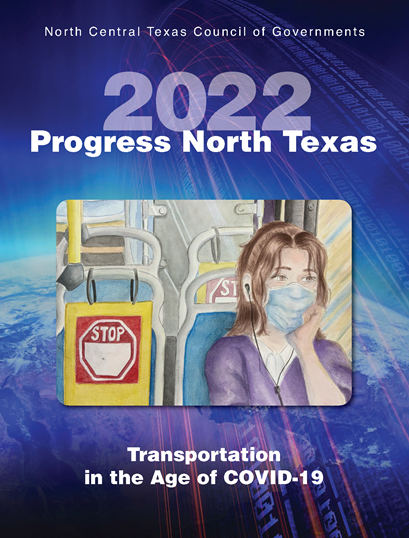
|
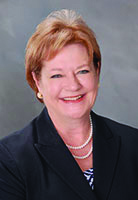 Dear Neighbors,
Dear Neighbors,
Thank you for reading Progress North Texas 2022. This year's theme is Transportation in the Age of COVID-19, which highlights how we are responding as a region to the pandemic while acknowledging where we’ve been over the past two years.
We have traveled a long road through COVID-19, and while it is certainly not over, we have the tools and understanding to keep ourselves, our coworkers and our loved ones healthy.
As chair of the Regional Transportation Council, I recognize that while virtual meetings have helped us remain productive, there is no substitute for face-to-face interactions.
In December, I had the pleasure of presiding over our first in-person RTC meeting since March 2020 when we gathered at the Irving Convention Center. While exercising caution by meeting in a large venue, we came together physically, strengthening relationships and further building camaraderie that is so critical to the decision-making process. Knowing the issues is one thing, but understanding how they impact other cities, counties and neighborhoods helps us as policymakers continue to put the region’s needs first.
Transportation affects every aspect of life, from education to grocery shopping, traveling to work to moving merchandise. And people are at the center. But COVID-19 has provided all of us an opportunity to assess how things can still be accomplished, but safely. Through this assessment we have learned a lot about how we can do our business safely in different ways, and sometimes there are improvements. In this year’s report, you will see the progress we’ve made and the work that remains.
Congratulations to Vianney Medellin, winner of the 2022 art contest, whose work you see on the cover. Vianney was among the many talented Dallas ISD students asked to illustrate how COVID-19 has influenced the way we travel. I had the pleasure of helping choose the winner, and it was a difficult decision. I walked away impressed with their talent and ability to use their artistic gifts to connect our world during these challenging times.
As you read Progress North Texas 2022, think about how far we have come in the past two years and how entities throughout Dallas-Fort Worth have learned to adjust to their surroundings to continue serving people’s transportation needs through some of the most trying circumstances we’ve ever faced. Then, get involved in the planning process.
Theresa M. Daniel, Ph.D
County Commissioner, Dallas County
Chair, Regional Transportation Council
The COVID-19 pandemic remained a top concern for North Texans in 2021. The emergence of vaccines helped people begin to slowly return to a sense of normalcy. Just like other sectors of the economy, the transportation system has been dealt many challenges by COVID it is still working to overcome.
Some, such as the decline in driving, led to unanticipated benefits. With fewer cars on the roads, traffic congestion declined as the pandemic set in and speeds increased. In 2021, as the recovery continued, more vehicles returned, and highway speeds crept closer to their pre-pandemic levels. However, speeds remained faster than before the pandemic.
Traffic Congestion
Congestion in Dallas-Fort Worth inched higher in 2021, according to the TomTom Congestion Index, which tracks the percentage of time congestion adds to commutes. Congestion increased from 13% to 17% in 2021. This put Dallas-Fort Worth 37th in the nation, better than Houston, Austin and Atlanta. The chart on the next page illustrates the current congestion level as well as all levels since 2008.
The region’s investment in transportation infrastructure, which has brought commuters choices of how to travel, has helped keep congestion levels manageable even as population has soared. The region has grown to almost 8 million, according to NCTCOG’s annual population estimates. The fastest-growing counties were Rockwall, Collin and Ellis.
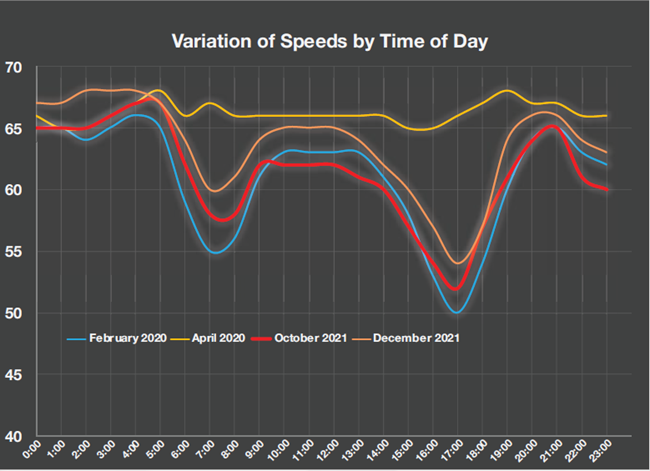 Traffic throughout the day continued to return to the region’s roadways in 2021, as workers returned to their offices. However, traffic remained lighter than before the pandemic. This chart shows how speeds have varied throughout the day since March 2020.
Traffic throughout the day continued to return to the region’s roadways in 2021, as workers returned to their offices. However, traffic remained lighter than before the pandemic. This chart shows how speeds have varied throughout the day since March 2020.
Traffic Counts
Traffic counts at the region’s permanent reporting stations began 2021 down 6%, showing incremental improvement throughout the year. Except for February 2021, which saw a 15% drop due to the winter storms, traffic was returning to its pre- pandemic levels. By December, counts were down just 0.7%. One example of the traffic rebound can be seen on the region’s tolled facilities. By June, usage By June, transactions on these facilities were ahead of what they were in June 2019.
Employers in the Dallas-Fort Worth area welcomed workers back to the office at a faster pace than many other metropolitan areas, according to Kastle Systems, which has studied data on employees returning to office buildings since the beginning of the pandemic.
Reducing Congestion through Policy
The pandemic has shown work can be done from anywhere. According to a Pew Research study, over 70% of people were working from home in late 2020.
 In spite of a slight increase in congestion, the roads continued to show they are capable of handling the growth in the region. In 2021, traffic congestion added 17% more time to the average commute. This is still lower than before the pandemic began.
In spite of a slight increase in congestion, the roads continued to show they are capable of handling the growth in the region. In 2021, traffic congestion added 17% more time to the average commute. This is still lower than before the pandemic began.
Policy may be one way to hold on to some of the gains. To sustain the benefits of changes in travel behavior on congestion experienced during the pandemic, NCTCOG established a regional trip reduction target. The resolution, approved by the Regional Transportation Council in June 2021, seeks to reduce drive-alone trips in North Texas by 20%. Achieving the target could lead to less congestion and improved transportation system efficiency and air quality.
Employers and employees can reach the target by using travel demand management strategies like carpooling, vanpooling, taking transit, biking/walking, telecommuting, or working a compressed work week/flexible work schedule once a week.
Through telecommuting, employers can retain employees and boost productivity, while moving closer to the 20% target. Progress toward the target can even be tracked on www.Tryparkingit.com.
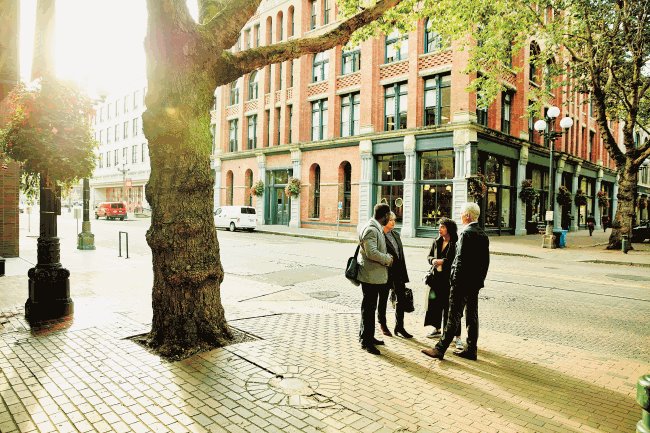 Workers are returning to office buildings in DFW faster than many other metropolitan areas.
Workers are returning to office buildings in DFW faster than many other metropolitan areas.
Major improvements to the region’s transportation system are moving forward, with approximately $1.2 billion in projects going to construction in 2021. In northern Dallas County, a 6.4-mile-long project on Interstate Highway 35E from IH 635 to the Denton County line will result in the widening of the main lanes of IH 35E and the reconstruction of the managed lanes. The project will relieve congestion for a rapidly growing area.
In the west, work began on a 2.2-mile-long project on US 287 from Union Pacific Railroad to Lone Star Road/FM 157, which will provide safety improvements in Johnson and Tarrant counties. The completed project will include an improved freeway, as well as bicycle/pedestrian access for those who travel along the corridor.
The Regional Transportation Council continued to fund smaller projects through the COVID-19 #00X Infrastructure Program in 2021. Approximately $175 million was approved for more than 40 projects during Round 4 of this program.
Federal Performance Measures
NCTCOG is federally required to monitor the condition of pavement and bridges along the 12,000 miles of the National Highway System as part of its performance measurement activities. These activities include the adoption of unique regional targets or affirmation and support of statewide targets for these measures. In December 2020, the RTC voted to reaffirm Texas Department of Transportation targets for pavement and bridge condition. NCTCOG will continue to track and report the condition of the region's pavement and bridges as data is available. For more on the federal measures being collected, visit www.nctcog.org/pm/fed.
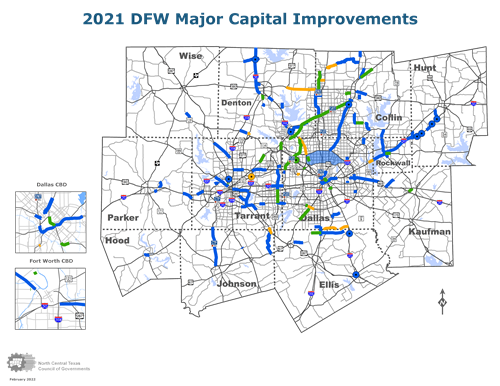
Approximately 81.5 miles of roadway improvements were completed in 2021, and 48 miles were under construction. These improvements will help North Texas accommodate the explosive growth it is experiencing.
NCTCOG is working with TxDOT and local governments to improve bridges across the region that have been determined to be in “poor condition.” An $8.8 million grant received before the pandemic is helping upgrade seven of these bridges. Four are either under construction or will be soon.
• US Highway 287 bridge over Lancaster Avenue in Fort Worth (under construction)
• US 180 bridge (under construction)
• IH 35W bridge in Alvarado (will be under construction early next year)
• Bridge on US 287 at Kerry Road was rolled into the Southeast Connector design- build project, which will be let for construction later this year.
Additionally, NCTCOG and governments in North Texas are coordinating on improvements to arterial streets not part of the National Highway System. With the passage of the Bipartisan Infrastructure Law, the region will see activities relating to asset management and resilience increase because of several new funding sources intended to address bridges needing repair.
2022-2023 Statewide Revenue Estimates
| Revenue Stream |
Estimate |
Increase over 2020- 21 biennium |
| State motor fuel taxes |
$2 billion |
3.6% |
| Oil and gas severance (Prop.1) |
$3.9 billion |
39% |
| Motor vehicle sales tax (Prop.7) |
$635 million |
100%* |
| General sales tax (Prop.7) |
$5 billion |
35% |
* This was the first time the threshold was met to receive the motor vehicle sales tax portion of Prop. 7.
Source: State Comptroller’s Office
Congestion Management Process Update
In 2021, the Dallas-Fort Worth Congestion Management Process, or CMP, was updated to incorporate new data and performance metrics. The CMP seeks a management solution to a growing traffic problem by targeting resources to operational management and travel demand reduction strategies. Although major capital investments are needed to meet growing demand, the CMP also develops lower-cost strategies that complement large infrastructure projects. The result is a more efficient and effective transportation system, increased mobility, safer travel and improved air quality.
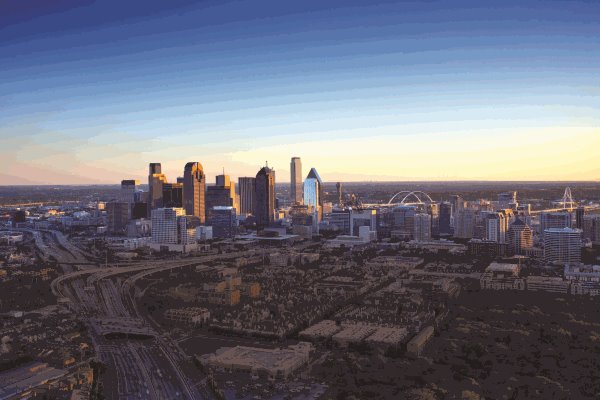
The CMP allows the region to sustain the optimal operations of the existing transportation infrastructure to get the most out of the current system. For more information, visit www.nctcog.org/cmp.
Comptroller Revenue
NCTCOG has been monitoring statewide comptroller revenue collections to better understand the impacts of COVID-19 on financial activity and to identify potential shortfalls in available funding for the region’s transportation system.
The comptroller’s certified revenue estimates suggest the next two years will result in significantly more funding as the recovery from COVID-19 accelerates. Combined with additional federal funding provided by the infrastructure law, more revenue at the state level will allow NCTCOG and its partners to meet future roadway challenges.
NCTCOG is focused on improving the safety of the transportation system with programs and projects that require coordination with partner agencies and the assistance of the driving public.
In 2021, the 12-county Dallas-Fort Worth area experienced 126,154 crashes, with 847 fatal crashes. The number of overall crashes has increased since 2020, as have those resulting in serious injuries and fatalities. As COVID restrictions eased and people returned to the roads, so did congestion, and the number of wrecks rose.
This data reflects the importance of training for agencies and responders responsible for managing and clearing traffic incidents on the region’s roadways. Their lives and the lives of motorists are in danger the longer they are exposed on the roadways. NCTCOG continues efforts to improve roadway safety by offering Traffic Incident Management training to local police, fire, wreckers, EMTs and courtesy patrol agencies. These agencies work together when responding to crashes to enhance safety for the driving public and emergency personnel. Collaboration also helps them clear crashes more quickly, which can reduce upstream traffic collisions.
More than 3,300 emergency responders from 132 cities and counties throughout the region have completed NCTCOG’s incident management.
Additional Incident Management Funding
The right equipment is essential to first responders’ efforts to keep the region’s roadways running smoothly. The NCTCOG Incident Management Freeway Blocking Equipment 2021 Call for Projects provided $1.4 million for the purchase of scene management blocking equipment such as crash attenuators, barriers and cushions. This equipment is used to protect first responders at crash scenes. Truck-mounted attenuators provide protection for incident responders and traveling motorists, while reducing damage to other vehicles. Using attenuators to block traffic at crash scenes means fire trucks can be protected from damage.
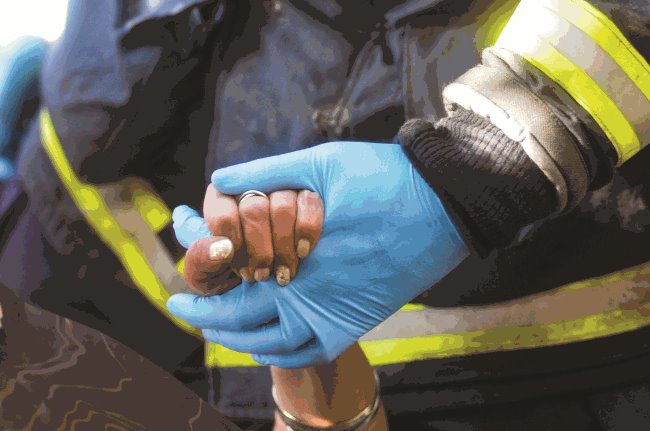
This is important because when a fire truck is struck and damaged, it is taken out of service. Additionally, this equipment is considered safer at the scene. The call for projects was open to public-sector partner agencies such as police, fire/EMS and courtesy patrol actively involved in traffic incident management in 12-county area. Agencies on the eastern side of the region were awarded approximately $1.2 million, while western agencies received about $200,000.
2021 Regional Crash Summary
| County |
Total Crashes |
Fatal Wrecks |
Fatalities |
| Collin |
12,379 |
50 |
51 |
| Dallas |
55,355 |
323 |
351 |
| Denton |
11,401 |
58 |
67 |
| Ellis |
3,290 |
33 |
35 |
| Hood |
804 |
13 |
13 |
| Hunt |
1,784 |
34 |
38 |
| Johnson |
2,775 |
36 |
38 |
| Kaufman |
2,226 |
33 |
37 |
| Parker |
2,641 |
28 |
28 |
| Rockwall |
1,749 |
10 |
10 |
| Tarrant |
30,669 |
212 |
228 |
| Wise |
1,021 |
17 |
21 |
| Total |
126,154 |
847 |
917 |
Source: TxDOT
Mobility Assistance
In 2021, mobility assistance patrols helped over 113,000 North Texas motorists with their disabled vehicles or provided protection to motorists or first responders on highways. The Dallas and Tarrant County Sheriff’s Offices manage the program along interstate corridors in Collin, Dallas, Denton and Tarrant counties. The North Texas Tollway Authority and private operators of LBJ Express and North Tarrant Express assist motorists on their roadways.
Drive Aware North Texas
Drive Aware North Texas is an educational effort introduced by NCTCOG to focus on improving the negative driving behaviors identified as the leading contributing factors in fatal and serious-injury crashes in the region. Speeding traditionally has been the top contributor to fatal and serious-injury crashes on the region’s roadways, playing a role in 33% of such crashes in 2020. To help combat this, this safety campaign focuses on younger drivers – specifically those between the ages of 16 and 24 – who typically speed more frequently. The effort also focuses on other factors, such as impaired and distracted driving. For more information, visit www.driveawarentx.org.
Additionally, NCTCOG and other Metropolitan Planning Organizations across Texas are working with TxDOT as part of a statewide task force established to make the roads safer.
Performance Measures
NCTCOG met the federal safety targets in 2020 for fatalities, fatality rate and non-motorized fatalities/serious injuries (bicycle-pedestrian). The target for serious injuries was narrowly missed. TxDOT has updated the statewide safety targets to be in line with Vision Zero. The RTC has a policy statement saying that “even one death on the transportation system is unacceptable.” The goal of Vision Zero is to have zero fatalities resulting from roadway crashes by 2050. For more information on performance measures, visit www.nctcog.org/pm/fed.
Safety Performance Measures
| Performance |
2020 Targets |
2020 Actual Performance |
| Fatalities |
589 |
587 |
| Fatality Rate |
0.803 |
0.803 |
| Serious Injuries |
3,514.70 |
3,560 |
| Serious Injury Rate |
4,768 |
4,891 |
| Non- Motorized Fatalities and Serious Injuries |
595 |
588 |
NCTCOG has embraced a series of federal targets in an effort to reduce fatalities and serious injuries. Many were met in 2020. Targets going forward are more stringent, as the region moves toward a goal of zero fatalities.
Freight Safety Initiative
Trucks and passenger vehicles interact daily, which can present possible life-threatening incidents. These can be mitigated through greater awareness and safer driving habits. NCTCOG undertook the Safe Driving Campaign in 2021. The goal of the campaign was to reduce freight-related wrecks and inform the public about safe-driving practices near large commercial motor vehicles.
The campaign used social media and other educational tools to encourage all drivers to think more about freight safety on the roadways and at railroad crossings.
The results from the initiative indicate the message of freight safety was seen and heard throughout the region on a variety of platforms. Here is a snapshot:
• 850,000+ Facebook impressions, 2,000+ post clicks.
• Almost 35 million drivers saw messages on nine billboards throughout the region.
• Radio ads resulted in over 15 million campaign impressions.
• 218,000+ impressions on podcast ads, 600+ clicks.
Rail Safety
Crashes at rail crossings have fallen dramatically over the past two decades and declined to 30 in 2021. For perspective, the region has more than 2,900 at-grade rail crossings. Although influenced primarily by traffic levels, the location and severity of incidents is helpful in determining which crossings present the highest safety risk to motorists, and therefore require additional safety measures or other types of remediation. One way at-grade crossings have been upgraded is the realignment of intersections to improve sight lines from both directions.
Operation Lifesaver and NCTCOG collaborated again for the 2021 Railroad Crossing Safety Campaign. The purpose of this campaign was to reduce crossing-related wrecks and inform the public about safe crossing practices. It is important to keep communities safe through continued rail-crossing education.
In addition, the Freight Safety Initiative promotes at-grade rail-crossing safety to help reduce the number of crossing incidents even more. NCTCOG will continue working with its partners to enhance the safety and efficiency of the entire freight network.
North Texas Moves
Progress continues on a project aimed at improving freight and passenger rail safety across the region. NCTCOG is using a $25 million federal grant received in 2020 to double-track 3.6 miles of the Trinity Railway Express commuter rail corridor. Currently, 20 miles are double-tracked. In addition, the North Texas MOVES (Multimodal Operations, Velocity, Efficiency, and Safety) Program will use the funding to implement a rail technology called the Regional Railroad Information System. This technology promotes network efficiency and helps partners understand the benefits of potential projects.
These projects are in the planning, design and pre-construction phase and will advance over the next few years. When complete, the projects will relieve congestion, improve regional air quality and increase safety in the TRE corridor. The full cost of North Texas Moves is $55 million.
Truck Travel Time Reliability
Truck Travel Time Reliability is a required federal performance measure that addresses how much time it should take truck drivers to get to their destinations. If trucks make deliveries on time consistently, the road network is reliable for truck traffic.
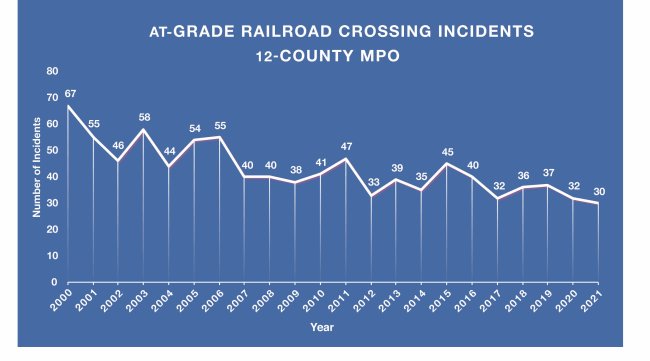 At-grade incident at the region’s 2,900 rail crossings fell in 2021 to their lowest level in more than 20 years of record keeping, according to data collected by NCTCOG.
At-grade incident at the region’s 2,900 rail crossings fell in 2021 to their lowest level in more than 20 years of record keeping, according to data collected by NCTCOG.
Truck Travel Time Reliability establishes the amount of time a truck driver needs to add to a median trip length to arrive on time. The lower the number, the better the travel time reliability. If the Truck Travel Time Reliability is 1.5 and the trip should take 60 minutes, it could take 90 minutes.
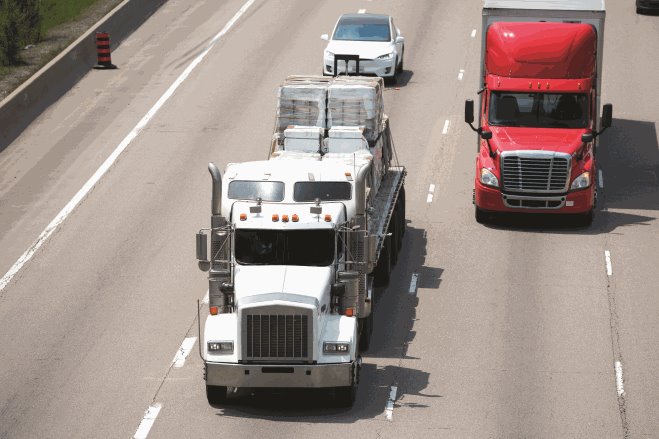 The pandemic has demonstrated the importance of efficiently moving goods throughout the region.
The pandemic has demonstrated the importance of efficiently moving goods throughout the region.
As the population has grown, travel times have traditionally become less reliable for freight. In 2017, for example, Truck Travel Time Reliability for the region was 1.73. By 2019, it had increased to 1.82. Due to the pandemic, in 2020, the measure improved to 1.60. In 2021, as traffic increased, the Truck Travel Time Reliability went up to 1.76. The goals for 2020 and 2022, based off the 2016-2019 trends, are 1.83 and 1.90.
To achieve current targets, truck bottlenecks, travel demand management and truck parking should be addressed in the region. NCTCOG encourages educating elected officials and the public regarding freight’s role in the Dallas-Fort Worth area. Staff also supports freight system planning to improve delivery time reliability. For more information, visit www.nctcog.org/pm/fed.
Ridership performance in 2021 showed steady improvement across various transit modes. While transit has been slower to rebound than other modes, people are returning. The region’s three major transit authorities provided a combined 25 million rides to customers in 2021. Data shows that the region's buses and trains experienced ridership growth throughout the year.
NCTCOG is coordinating with Dallas Area Rapid Transit, the Denton County Transportation Authority and Trinity Metro to remind the region that public transit providers have followed strict health and safety protocols since the beginning of the pandemic and are ready to welcome riders back. For more information on 2021 ridership trends, visit www.nctcog.org/transittrends.
Keeping Transit Moving
Many of the region’s public transportation agencies reported driver shortages in 2021. The lasting challenges associated with the pandemic, increased competition and changing work patterns all contributed to agencies’ difficulty recruiting and retaining these critical employees. Federal COVID-19 assistance programs continued to help the region’s transit agencies with operational expenses in 2021. The region has received more than $800 million in COVID relief to help keep transit moving. Agencies focused on improved recruitment of quality candidates, turning to on-the-spot hiring, driver incentives, and increased staff wages to increase recruitment. Employees who feel valued by their agencies have better longevity and help to attract a larger pool of potential drivers.
Vanpool Performance
The Regional Vanpool Program provides access to employment for workers whose commute trips are not served by other transit options. In 2021, there were 150 active vanpools, and the program saved approximately 19 million miles of travel on the roadway system. The Regional Transportation Council has approved modifications designed to ensure the program serves the region as effectively as possible. For more information on the Regional Vanpool Program visit www.nctcog.org/vanpool.
Passenger Trips for Smaller Providers
| Transit Provider |
Service Area |
Trips |
| City/County Transportation |
Johnson County |
23,097 |
| Community Transit Service |
Ellis and Navarro counties |
25,913 |
| Public Transit Services |
Parker and Palo Pinto counties |
44,715 |
| Span, Inc. |
Denton County |
28,658 |
| STAR Transit |
Kaufman,Rockwall and Dallas counties |
127,502 |
| |
|
|
| Total |
|
249,885 |
RAISE Grant
Last year, NCTCOG secured over $8 million from the US Department of Transportation to improve mobility in the Southern Dallas Inland Port. The project aims to optimize transit service in the area by using compact electric buses and making strategic improvements to pedestrian and traffic signalization infrastructure. The project will expands access and support safe mobility to employment, education, healthcare and other life essential opportunities. NCTCOG is coordinating with the Federal Transit Administration and project partners to address the next steps in the grant administration process.
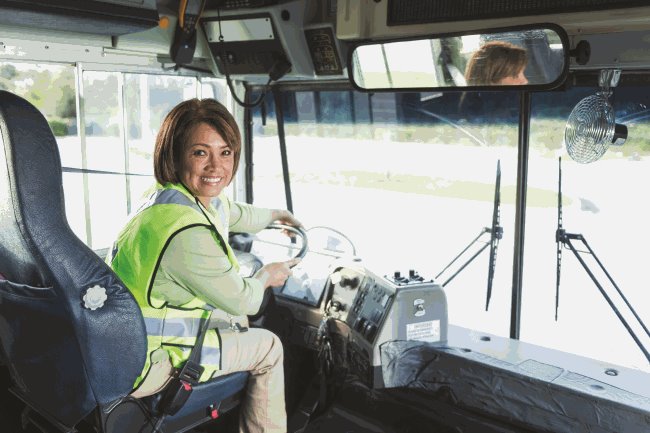
Bus Network Redesigns
The bus networks of DART, DCTA and Trinity Metro have all undergone significant redesigns. DART’s and Trinity Metro’s changes focus on attracting additional ridership through increased frequency, more direct routes to popular destinations and better connections to existing regional services. DCTA’s redesigned network focuses on attracting ridership and enhancing connections to additional destinations by relying more on the on-demand rideshare model to complement fixed-route bus service.
Transit Studies
NCTCOG completed three transit studies in 2021 that focused on developing a comprehensive approach to planning and implementing transit options in areas of Collin, Dallas and Tarrant counties outside transit authority service areas.
Average Bus Ridership by Quarter*
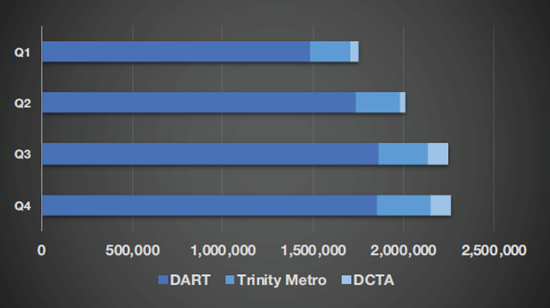
 * Calendar year (2021). Despite the challenges of the pandemic, transit ridership is growing in North Texas. Bus ridership increased each quarter. Sources: DART, DCTA and Trinity Metro
* Calendar year (2021). Despite the challenges of the pandemic, transit ridership is growing in North Texas. Bus ridership increased each quarter. Sources: DART, DCTA and Trinity Metro
The Collin County study also evaluated the feasibility of passenger rail service along the Irving to Frisco rail corridor. Each study:
• Examined transit needs and demand
• Identified opportunities to expand and improve service
• Developed transit options based on analysis and public and stakeholder input
Plans were developed that advance the recommendations in each study area and guide municipalities in their implementation of services that address local and regional needs, priorities and goals. For more information, visit www.nctcog.org/transitstudies.
Federal Performance Measures
Transit Safety
The Public Transit Safety Action Plan and associated regional targets were approved in May 2021. The goal of the targets is to achieve a 5% improvement over the regional baseline average performance by Fiscal Year 2025. However, fatality targets are set to zero, in line with the RTC’s safety position.
Transit Asset Management
NCTCOG is required by federal legislation to set regional transit asset management targets and evaluate the performance of various transit assets annually in coordination with transit providers. The regional targets and tracking of transit assets focus on ensuring public transportation vehicles, rail lines and other capital assets are in a state of good repair. Overall, most regional targets are being met for many of the asset categories, based on Fiscal Year 2020 data. For more information, visit www.nctcog.org/pm/fed.
Regional Safety and Performance
| Category |
Measure |
Baseline Annual Average* |
Adopted Target |
| Fatalities |
Total Number |
6.0 |
0.00 |
| |
Rate per 100k miles |
0.01 |
0.00 |
| Injuries |
Total Number |
151 |
143 |
| |
Rate per 100k miles |
0.23 |
0.22 |
| Safety Events |
Total Number |
516.00 |
490 |
| |
Rate per 100k miles |
0.81 |
0.77 |
| System Reliability |
Miles between major mechanical failures |
18,896.00 |
19,841.00 |
*Average of annual data reported by transit providers to the National Transit Database between 2016 - 2019.
North Texas is in nonattainment for ozone pollution and relies on a combination of policies, programs and projects, along with close coordination with local partners to reduce emissions and protect residents’ health. Despite the changing work patterns brought about by the pandemic, the region is still trying to meet two standards for ozone concentration. One was established in 2008 (75 parts per billion), for which 10 counties are in nonattainment. The other is from 2015 (70 ppb), and affects nine counties.
The region narrowly missed attainment for the 2008 standard last year, ending ozone season with a design value of 76 ppb for the second consecutive year. Due to missing compliance deadlines, the region will be reclassified from Serious to Severe under the 2008 standard and from Marginal to Moderate under the 2015 standard. NCTCOG will continue working toward attainment of both standards with the help of partners and residents.
Mobile Sources
Light-duty vehicles make up over 40% of on-road nitrogen oxide (NOx) emissions and heavy-duty vehicles account for about 50%. NCTCOG closely monitors nitrogen oxides and volatile organic compounds (VOC), which interact to form ground-level ozone, as part of its commitment to track federal performance measures. With the implementation of new projects such as bicycle-pedestrian trails, intersection improvements and regional efforts to improve traffic signal timing, NOx and VOCs have declined. NCTCOG is working with partners to identify more projects that could allow this progress to continue. For more information, visit www.nctcog.org/pm/fed.
Alternative Fuel Growth
One way to help the region reach attainment is by adopting alternative fuel and electric vehicles. EVs, including battery electric vehicles and plug-in hybrid electric vehicles, are of particular interest to consumers in North Texas. These two types account for more than 40,000 vehicles in the region. Interest in EVs was reflected in the attendance at Dallas-Fort Worth Clean Cities’ National Drive Electric Week (NDEW) event in 2021.
In October, DFW Clean Cities hosted the annual outdoor NDEW event, bringing the public together to showcase EVs and EV owners. This was one of the largest events to date, with almost 800 attendees and more than 200 EVs registered.
2021 Ozone Progess
8-hour Ozone NAAQS Historical Trends
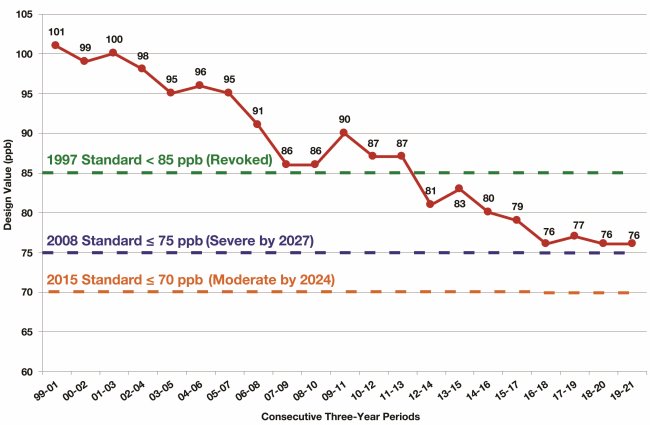 Ozone attainment is reached when, at each monitor, the Design Value (the three-year average of the annual fourth-highest daily maximum eight-hour average ozone concentration) is less than or equal to 75 ppb for the standard established in 2008 and 70 ppb for the standard established in 2015.
Ozone attainment is reached when, at each monitor, the Design Value (the three-year average of the annual fourth-highest daily maximum eight-hour average ozone concentration) is less than or equal to 75 ppb for the standard established in 2008 and 70 ppb for the standard established in 2015.
Public agencies have also increased their adoption of alternative fuel and electric vehicles. A few accomplishments of note in 2021 are:
1. Everman Independent School District operated all-electric school buses for a full year.
2. The cities of North Richland Hills and Grapevine adopted hybrid police vehicles.
3. Denton and Prosper ISDs added 18 and 10 new propane school buses, respectively.
4. Dallas Fort Worth International Airport and Dallas Area Rapid Transit fleets continued to use both compressed natural gas and renewable natural gas.
For more information on alternative fuel vehicle accomplishments, visit www.dfwcleancities.org/fleetrecognition.
Finally, there was increasing interest in hydrogen fuel cell vehicle deployment, especially in the private sector. Hydrogen fuel cell EVs are of growing interest for freight movement, where the extra weight of batteries can be a disadvantage.
Temporary Vehicle Tags
Texas temporary vehicle tags are issued to allow a vehicle buyer to legally operate a vehicle before permanent license plates are obtained. The region has experienced an increase in temporary tags since the Two Steps One Sticker program began in 2015.
Due to the ease of creating, selling and printing temporary paper tags, data shows that tens of thousands of vehicles in North Texas are improperly registered and lack required vehicle emissions inspections. These temporary tags cost the state and counties revenue. North Texas is working to correct this problem through partnerships with law enforcement and other state agencies.
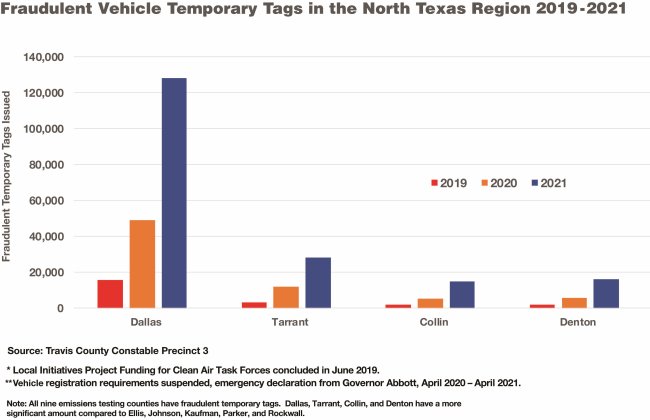 Data shows that tens of thousands of vehicles in North Texas are improperly registered and lack required vehicle emissions inspections. This chart shows the four counties with the most fraudulent temporary tags. NCTCOG is working to identify funding to develop task forces to help ensure vehicles are properly registered.
Data shows that tens of thousands of vehicles in North Texas are improperly registered and lack required vehicle emissions inspections. This chart shows the four counties with the most fraudulent temporary tags. NCTCOG is working to identify funding to develop task forces to help ensure vehicles are properly registered.
NCTCOG and the Regional Transportation Council are obtaining federal funds to start emissions enforcement task forces in the region. The task forces will be responsible for curbing the abuse of temporary tags, improper inspections and emissions-component tampering.
Engine Off North Texas
Engine Off North Texas aims to reduce unnecessary idling from heavy-duty diesel trucks by encouraging local governments and businesses to adopt and enforce idle-reduction policies and install infrastructure such as electrified parking spaces. Engine Off North Texas offers guidance and educational materials for no charge. North Texans can also report excessive idling from heavy-duty diesel trucks to NCTCOG by calling 877-NTX-IDLE (877-689-4353), which will result in vehicle owners being notified. For more information, visit www.engineoffnorthtexas.org.
DFW Clean Cities
DFW Clean Cities works to advance energy security, protect environmental and public health and stimulate economic development with strategies to reduce transportation energy impacts and improve air quality. Clean Cities focuses primarily on the transportation sector, collaborating with vehicle fleets to increase the use of alternative fuel vehicles, reduce idling and implement other fleet efficiency practices. For more information, visit www.dfwcleancities.org.
Clean Fleet Policy
Fleets operating in the region are encouraged to adopt the RTC’s Clean Fleet Policy. This policy provides a framework for efficient and low- emitting operations, which helps the region work toward attainment of the federal ozone standards and improve overall air quality. Fleets adopting the policy may apply for clean vehicle funding made available by the RTC. For more information visit www.nctcog.org/fleetpolicy.
2021 Fleet Recognition Awardees
Fleet operators that adopt the Clean Fleet Policy and complete the Clean Cities Annual Survey are eligible for Fleet Recognition Awards. In 2021, participating fleets helped reduce the equivalent of almost 24 million gasoline gallons, 734,089 pounds of ozone-forming NOx and 125,058 tons of greenhouse gas emissions. For more information, visit www.dfwcleancities.org/fleetrecognition.
IH 45 Zero-Emission Vehicle Plan
NCTCOG is drafting the Interstate Highway 45 Zero-Emission Vehicle Deployment Plan outlining how to build out infrastructure along IH 45 to support both battery electric and fuel cell electric vehicle travel, with a focus on supporting medium- and heavy-duty vehicles. This corridor, which carries a large amount of freight, is key to advancing air quality efforts in Dallas-Fort Worth and Houston as both face ozone nonattainment challenges that are impacted by heavy-duty diesel vehicles. For more information, visit www.nctcog.org/IH45-ZEV.
Organic Waste Fuel Study
DFW Clean Cities is supporting the NCTCOG Environment and Development Department on a project to explore the potential for organic waste, anaerobic technologies and renewable natural gas (RNG) in the region. This project will examine potential feedstocks for RNG production and demand for RNG vehicles in the region. For more information, visit www.nctcog.org/envir.
Multi-Family Electric Vehicle Supply Equipment Analysis
Through the Electric Vehicles North Texas initiative, DFW Clean Cities analyzed the accessibility of public EV charging stations in Dallas and Denton on multi-family properties and environmental justice areas. More information can be found at www.dfwcleancities.org/multifamily.
The region’s bicycle and pedestrian trails continued to be a bright spot of the transportation system in 2021. Beginning early in the pandemic, all other modes of transportation experienced a sharp decline. Active transportation surged dramatically in 2020 and remained higher throughout 2021, based on data collected at various trail locations.
Since the beginning of the pandemic, bicycling and walking on trails in the region have maintained an overall pattern of double-digit growth, compared to trends recorded in roadway volumes, transit ridership and airport passengers. Most modes of transportation recovered by late 2021.
For example, in December 2021, bicycling and walking on trails were up 32% while freeway traffic was down by approximately 1%, compared to before the pandemic. That same month, airports saw 10% fewer passengers compared to 2019.
The only month active transportation declined was February 2021, when the region was hit by a weeklong winter storm. Precipitation such as rain and snow are known factors impacting people's decisions to walk and bicycle.
Balch Springs Hickory Tree Road Project
The pandemic has created changes to traditional processes in other ways. NCTCOG has concluded a corridor-planning study in Balch Springs for Hickory Tree Road, between Bruton and Elam roads. The project aims to increase bicycle and pedestrian safety and access, decrease congestion and spur economic development.
The planning study was addressed with a combination of virtual and in-person activities due to COVID-19. Public engagement was completed in a virtual-only format, including an online survey, virtual stakeholder meetings and a virtual open house.
The recommendations for Hickory Tree Road include adding a continuous center turn lane, pedestrian refuge islands at key locations, and enhanced bicycle and pedestrian infrastructure. Improvements are intended to maximize access to businesses and increase safety and comfort of pedestrians and cyclists. Construction of Phase 1, between Lake June and Elam roads, has received federal and state funds and is planned for Fiscal Year 2025. View the Balch Springs Hickory Tree Road Planning Study at www.nctcog.org/landuseplanning.
DFW Trail Use (2021)
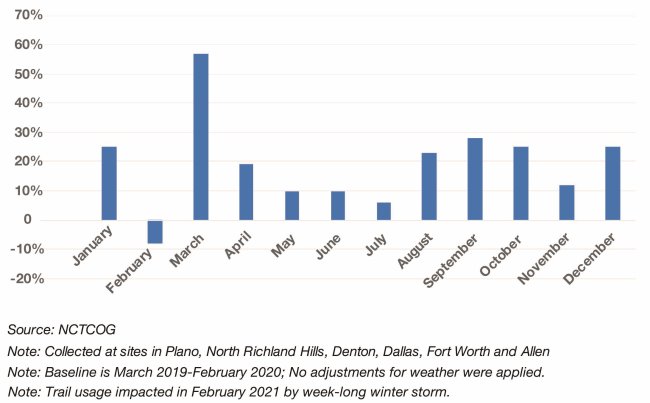 Regional trail use remained strong in 2021, compared to before the pandemic. With the exception of February, trail use was up substantially each month over 2019.
Regional trail use remained strong in 2021, compared to before the pandemic. With the exception of February, trail use was up substantially each month over 2019.
The land-use analysis is anticipated to be completed in 2021 and will include a policy toolkit that cities can use when planning for new freight land-use development. The toolkit will also explain how to protect and preserve existing freight infrastructure and the surrounding communities, by ensuring they act as “good neighbors.”
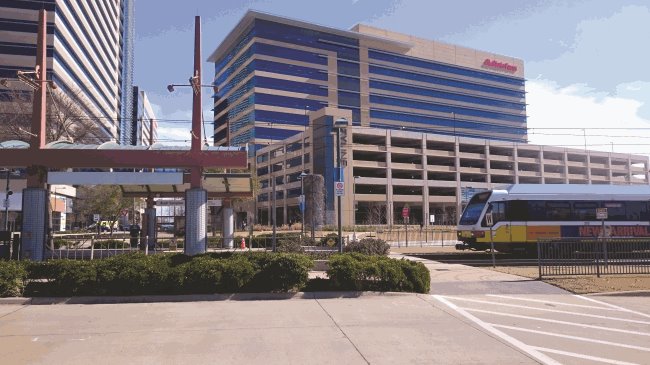 NCTCOG completed an inventory of TOD projects, looking at 238 developments around 74 rail stations. Source: DART
NCTCOG completed an inventory of TOD projects, looking at 238 developments around 74 rail stations. Source: DART
DART Transit-Oriented Development Study
NCTCOG completed the final report of Dallas Area Rapid Transit Red and Blue Lines Corridors Transit-Oriented Development Study in summer 2021. The study focused on understanding current infrastructure, market and policy conditions shaping development of TOD in the two oldest corridors of the DART light rail system. Phases of the study included an evaluation of station-area sidewalk and bicycle first-/last- mile needs and a study of parking at 16 transit-oriented developments. Residents, businesses and employees up to one mile from the stations were also surveyed. These previous findings were combined with a new corridor-wide synthesis of TOD performance and context, including topics such as zoning, planning, a TOD project inventory, economic development and demographics. Recommendations for the corridor cover various areas, including housing, zoning and increasing station-area specific planning. View the full plan at www.nctcog.org/TOD.
The Dallas LOOP Trail: RAISE Grant Award
NCTCOG helped TxDOT secure a $12 million federal grant for the final segment of the Dallas LOOP Trail and replacement of the Lake June Road overpass at US Highway 175 with a safer crossing. The LOOP will connect 39 miles of existing trails with 11 miles of newly built trails. This project will improve access to public transportation with the addition of connections across major roadways to help pedestrians access the Lake June and Lawnview DART stations. The new bridge and improved Lake June Road interchange will also allow passenger and freight traffic to move more efficiently and safely along US 175.
TOD Inventory
The recently completed North Texas regional Transit-Oriented Development Inventory consists of 238 developments around 74 of the region’s 85 rail transit stations. The Inventory serves as a resource for TOD planning, evaluation and implementation. To recognize the unique context of North Texas and inform discussions of best practices, each development was scored on a series of TOD design criteria. Only 25 TODs received the highest score and were determined to meet all national standard design criteria. This indicates room to improve local design for transit orientation. The next phase of the project will be developing an inventory of TODs in the downtowns of Dallas and Fort Worth. Additional information is available at the following: www.nctcog.org/TOD.
Like most transportation modes, commercial aviation saw significant declines when the pandemic began. But the aviation activity in North Texas showed substantial improvement after declines in operations and passenger loads of 90% early in the pandemic. That 90% would end up being only a 50% decline in activity by the end of 2020. The recovery continued into 2021. Dallas Fort Worth International Airport experienced a nearly 30% increase in daily flights in 2021, while Love Field saw a gain of approximately 25%.
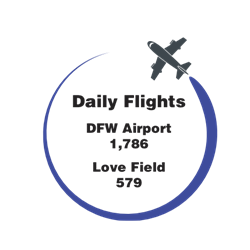
DFW Airport daily flights increased from just over 1,400 in 2020 to 1,786 in 2021. Love Field’s daily flights grew from 465 in 2020 to 579 in 2021. Operations were still below 2019 but are forecast to continue improving in the future as the region recovers. Together, the airports have the ability to operate more than 5,100 flights per day.
Just as North Texas is a center for commercial aviation, the region is laying the groundwork for the use of unmanned aircraft, or drones. Drones are becoming more common for use in business, public safety and recreational purposes. NCTCOG continued to host monthly drone virtual workshops to help professional operators and hobbyists remain up to date on the rules and regulations governing drone use, as well as best practices.
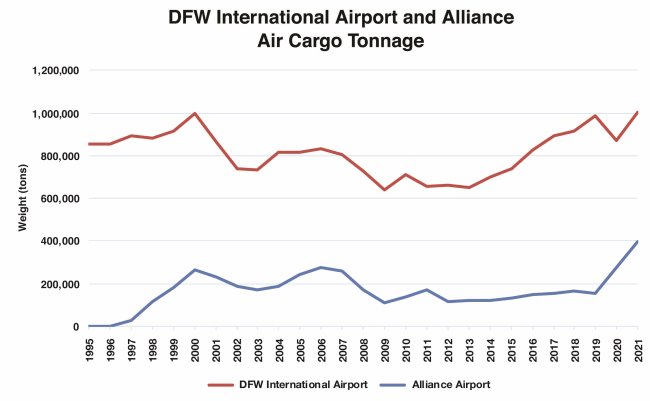 DFW Airport and Alliance Airport, the region’s air cargo leaders, saw significant increases in cargo transported in 2021. DFW Airport surpassed 1 million tons moved in 2021, returning to a positive trajectory after declining in 2020. At Alliance Airport, which recorded an increase in 2020, the trend continued in 2021, with air cargo up over 40%. Source: DFW Airport, Alliance Airport
DFW Airport and Alliance Airport, the region’s air cargo leaders, saw significant increases in cargo transported in 2021. DFW Airport surpassed 1 million tons moved in 2021, returning to a positive trajectory after declining in 2020. At Alliance Airport, which recorded an increase in 2020, the trend continued in 2021, with air cargo up over 40%. Source: DFW Airport, Alliance Airport
NASA Agreement
A high-profile agency has taken notice. NCTCOG entered into an agreement with the National Aeronautics and Space Administration in 2021 to study the potential of drone technology and integrate it into future transportation plans. NASA is working with NCTCOG and a group of public- and private-sector partners to study cargo-carrying drones and automated air taxis.
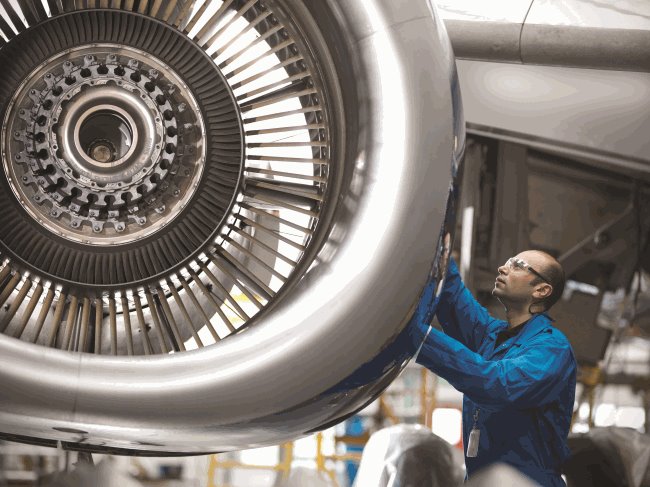 By 2026, the region will need more than 800 mechanics and service technicians to meet the demand of the growth in the aviation industry.
By 2026, the region will need more than 800 mechanics and service technicians to meet the demand of the growth in the aviation industry.
One example of how this partnership is benefiting the region is the Airspace Hazard Identification and Alerting Service being developed by the University of North Texas. This project, being assisted by the North Texas Center for Mobility Technologies, seeks to find safer, more efficient ways to move people and goods with drones.
Arlington UAS Pilot Program
A test program with the City of Arlington seeks to address the UAS advancement gap in North Texas by enhancing local research, improving public safety and helping build the case for investment in UAS airspace management infrastructure. Arlington is working with public, private and research partners on the technology needed to allow numerous drones to fly safely over longer distances without fear they will collide with other aircraft or objects on the ground, or threaten public safety.
During the 2021 NFL season, the city tracked the low-altitude airspace around AT&T Stadium starting three hours before kickoff through each game’s conclusion. Over the course of nine Dallas Cowboys home games, they tracked 48 drone events with 22 unsafe flights. A drone flight is considered unsafe if it flies over pedestrians, stadium operations or inside of an area with a temporary flight restriction.
Employee Needs
Between 2021 and 2026, local airlines will need more than 500 pilots and flight engineers and more than 800 mechanics and service technicians to meet the demands of the growth in aviation, according to a survey by North Texas InterLink Inc. The survey included responses from more than 1,100 regional employers. NCTCOG is collaborating with partners to develop a program to accommodate the aviation industry's workforce development needs. The goal is to enable this evolving industry to continue meeting traditional needs while adapting to change.
The rapid growth experienced in Dallas-Fort Worth calls for advanced ideas to propel the region forward so it remains a hotspot for transportation solutions. North Texas addresses the needs of its transportation system through a variety of partnerships as it seeks a long-term approach to system improvements. Some technology applications, such as a new mobile app for carpooling, are in use and paying dividends for the transportation system. Others are in the development stage and could and revolutionize the way North Texans move.
GoCarma
As businesses continued reopening in 2021 and people returned to working in office buildings, commute patterns normalized. With freeway volumes returning to pre-pandemic levels by December, sharing a ride was once again an alternative for many North Texans to get to work or important appointments safely and reliably.
Those who choose to share a ride with co-workers, family or friends can save 50% on peak-period tolls on TEXpress Lanes across Dallas-Fort Worth with the FREE GoCarma app. In 2021, almost 12,500 new users signed up for GoCarma. Users recorded approximately 1 million TEXpress Lane transactions, an increase of almost 9% over 2020. For more information, visit www.gocarma.com/dfw.
AV2.0
NCTCOG’s Automated Vehicle Program 2.0, is helping the region prepare for the widespread adoption of automated vehicles. Work continued on AV2.1, the regional transportation technology planning exercise, with a series of public meetings. Learn more at www.connectNTXfutures.org.
The Regional Transportation Council has committed funding to help local partners host automated vehicle deployments (AV2.2) and explore use cases that further regional priorities (AV2.3).
 In 2021, there were 1 million GoCarma transactions on the region’s TEXpress Lanes, a 9% increase over the previous year. North Texans can receive a 50% peak-period discount on their trips using the GoCarma app.
In 2021, there were 1 million GoCarma transactions on the region’s TEXpress Lanes, a 9% increase over the previous year. North Texans can receive a 50% peak-period discount on their trips using the GoCarma app.
The RTC approved the first round of projects in 2021. The projects included a wide range of technology solutions, such as an electric and automated bus route (DART); an AV truck port (Fort Worth); sidewalk robots delivering produce in a food desert (Paul Quinn College) and a smart infrastructure district that will host an AV deployment (Richardson). Assistance did not stop there.
Last year, staff provided technical assistance to local partners considering applications for the second round of proposals. Early in 2022, the second slate of projects were approved. They were:
• Service delivery programs using automated vehicle platforms in McKinney and South Dallas
• Expansion of an on-demand shuttle service in Arlington
• An automated parking/curb management test bed at DFW Airport
• Technology projects in south and southeast Fort Worth to enhance broadband connectivity for area residents and businesses
High-Speed Rail
With the planned high-speed rail service from Dallas to Houston a few years away, work continues on a network that could whisk passengers across the region – and even to South Texas – in minutes.
The Dallas-Fort Worth High-Speed Transportation Connections Study is helping planners determine how to provide the region with access to high-speed technologies.
Virtual public meetings were held in January and May, allowing residents to weigh in online or over the phone. In October, NCTCOG held in-person open houses at large venues throughout the region to review recommendations from Phase 1 of the study.
The events – in Fort Worth, Arlington, Grand Prairie and Dallas –provided future users of the technology the chance to see first hand how high-speed rail could help revolutionize travel.
The RTC is moving forward with high-speed rail near Interstate Highway 30 after considering several options, including hyperloop. Although hyperloop was not selected for this project, there may be applications that make sense elsewhere in the region.
The next phase of this study examines potential environmental effects on everything from air quality to noise, wetlands, wildlife, water crossing, and neighborhoods and businesses in the corridor. It will be conducted following federal guidelines. NCTCOG is coordinating with the Federal Railroad Administration and Federal Transit Administration on next steps to enter into the National Environmental Policy Act (NEPA) study for this corridor, while also continuing to monitor the real-world readiness of hyperloop technology.
Virtual Public Meeting Attendance
| |
Online |
Telephone |
Total |
| January 27 |
106 |
1 |
107 |
| January 29 |
63 |
8 |
71 |
| May 19 |
98 |
8 |
107 |
| May 20 |
37 |
5 |
42 |
Efforts to advance high-speed transportation in Dallas-Fort Worth continued in 2021 with both online and in-person opportunities for the public to weigh in on the project. High-speed rail has reached the environmental phase.
These projects represent a portion of the work being advanced by NCTCOG and supported by the RTC to improve the efficiency of the transportation system for both current and future users.
The lasting effects of the COVID-19 pandemic continue to reshape how NCTCOG communicates with the public. Through most of 2021, meetings were held virtually. But as COVID-19 case numbers declined, people became more comfortable gathering in public. And a new flexible alternative to exclusively in-person engagement emerged – the hybrid approach. This allows people to attend in person or watch live online.
Data shows North Texans remain interested in virtual engagement opportunities. For example, there was an 11% increase in live views of RTC meetings, and those who attended virtually spent more time watching. The RTC met exclusively virtually throughout most of 2021, gathering in person for the first time in December at the Irving Convention Center.
The Dallas-Fort Worth High-Speed Transportation Connections Study was an effort that allowed NCTCOG to combine traditional and innovative outreach techniques. Virtual meetings were held in January and May. In October, a series of in-person workshops throughout the corridor allowed planners to speak directly with residents and stakeholders about the progress of the project. To keep the public safe, large venues were chosen.
Social Media
Social media also provided an opportunity to remain engaged through the pandemic. NCTCOG’s followers on Twitter and Facebook grew by a combined 9% in 2021. Users were most engaged with posts about public meetings, forums and outreach events. Other popular topics included air quality, ozone and sustainability. In total, the top five topics reached 281,591 users on those social media sites.
Top Five Social Media Topics of 2021
| Topic |
Reach |
Share of Reach |
| Public Meetings/Forums/Comments/Outreach/Events |
132,125 |
35.5% |
| Air Quality/Ozone/Sustainability |
49,017 |
13.2% |
| Roadway/ Projects/Planning/Programs |
41,438 |
11.1% |
| Bicycle/Pedestrian |
38,137 |
10.2% |
| Safety/Tips |
20,874 |
5.6% |
| Total |
281,591 |
|
| |
|
|
These are the five most engaging topics covered on the department’s Facebook and
Twitter pages in 2021.
Media Relations
NCTCOG regularly interacts with reporters to deliver information on transportation and air quality to regional and national audiences. NCTCOG distributed more than 30 transportation press releases, and staff participated in over 50 media interviews in 2021. NCTCOG was mentioned in more than 150 media reports. Requests ranged from traditional transportation topics to those attracting more national attention, such as automated vehicles and work with NASA to integrate drone technology into regional planning.
 In-person meetings are back, but there will continue to be a desire to gather virtually, even after the pandemic. NCTCOG has used a hybrid approach to meetings since 2021.
In-person meetings are back, but there will continue to be a desire to gather virtually, even after the pandemic. NCTCOG has used a hybrid approach to meetings since 2021.
Online Tools
NCTCOG has further embraced the variety of online tools available to stay connected with the residents and businesses. Map Your Experience is designed to gather crowdsourced data about the region’s transportation system. It collects information from travelers about issues they have with the system. MYE is available in both English and Spanish and provides an interactive experience for the user and valuable information to NCTCOG that can help solve transportation problems.
Engagement tools such as MYE provide planners with early feedback on issues that might otherwise go unseen until later in the process. Planners can analyze where comments originate and then pursue targeted outreach to areas and remove potential barriers preventing meaningful participation. To learn more and to provide input, visit www.nctcog.org/mapyourexperience.
Environmental Justice
COVID-19 has highlighted the disparities that plague low-income communities and communities of color. Despite laws and policies in place to make transportation more accessible to all, issues such as low access to healthy food, medical care and active transportation infrastructure remain. NCTCOG uses the Environmental Justice Index to identify groups protected by federal environmental justice requirements to help resolve disparities impacted by transportation planning activities.
To determine potential impacts on different communities, planners ask questions such as:
• Do low-income residents face disproportionately long commutes or high transportation costs?
• Do people of color live in areas where a greater percentage of highway pavement is in poor condition compared with other areas?
• Do different communities face different air quality risks from the transportation system?
For more information, visit www.nctcog.org/EJ.
Communities are constantly changing. If issues are not addressed early on in the planning process, they may arise later when they could be more difficult to mitigate. NCTCOG is using a combination of innovative and traditional measures to meet people’s transportation needs. Whether you can participate in person or online, your input is valuable to the process. Tell us what you think . . . we are listening.
 2021 was marked by tremendous progress in the fight against COVID-19. While there were challenges, we are in a much better position than we were just one year ago. Vaccines are widely available, and those choosing to get them can find them easily.
2021 was marked by tremendous progress in the fight against COVID-19. While there were challenges, we are in a much better position than we were just one year ago. Vaccines are widely available, and those choosing to get them can find them easily.
While the pandemic undoubtedly continues to shape how we live, work and go to school, things are steadily moving toward normal. You don’t have to look far to see evidence of this. Restaurants are full. Concertgoers are being entertained by their favorite musical acts. Sports fans are cheering loudly for the home teams. And this spring, community events are back. NCTCOG has participated in numerous outdoor events across the region, and it has been so great to see smiling faces again.
The transportation system is coming back, too, particularly as we return to offices after being at home so long. Some people are back in the office full-time, while others have returned a few days a week and are working from home the rest of the week. Still others are telecommuting every day. Whatever your needs, the transportation system is here to help you get to where you need to go. Whether you drive, ride transit, choose active transportation or a combination of any of these modes, resources are being put in place to make your trips safer and more efficient. NCTCOG will continue working closely with local, state and federal partners to build on the progress we are all witnessing.
--Brian Wilson Communications Supervisor
NCTCOG
We were pleased to partner with the Dallas Independent School District on this year’s art contest. We asked students to illustrate how transportation has changed for them as we have navigated the COVID-19 pandemic. Congratulations to Vianney Medellin, this year’s winner. Vianney’s artwork is on the cover of this report. The top finishers in this year’s competition are included below. We want to thank the students and teachers who participated in the competition. All the art submitted was outstanding, and it was difficult to select a winner.
Art Contest Winners
|
|
|
|
First Place
Vianney Medellin
8th grade
Dallas ISD
|
Second Place
Penelope Levings
8th grade
Dallas ISD
|
|
|
|
|
Third Place
Marlene Posada
8th grade
Dallas ISD
|
Fourth Place
Xitiali Martinez
8th grade
Dallas ISD
|
|
|
|
Fifth Place
Kimberly Avalos
8th grade
Dallas ISD
|
All graphics are from NCTCOG, and all photos are from Getty Images, unless otherwise indicated.